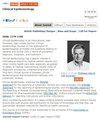Time Trends in Male Breast Cancer Incidence, Mortality, and Survival in Austria (1983–2017)
IF 3.4
2区 医学
Q1 PUBLIC, ENVIRONMENTAL & OCCUPATIONAL HEALTH
引用次数: 0
Abstract
Background: Male breast cancer (MBC) comprises less than 1% of all breast cancer cases globally and remains understudied with persisting sex-specific survival disadvantages. We aim to contribute to better understanding of MBC with a comprehensive analysis of time-trends over several decades in Austria.Methods: We used Austrian National Cancer Registry data on 1648 cases of MBC cases diagnosed between 1983 and 2017 in Austria. Overall incidence, mortality, and survival rates, as well as age-, stage-, and period-specific incidence and survival rates were calculated. Joinpoint regression was performed to assess trends.
Results: MBC incidence rates increased throughout the whole observation period (1983– 2017) with an annual percent change (APC) of 1.44% (95% confidence interval, CI: 0.77 to 2.11). During the same period, morality rates were stable (APC: – 0.25, 95% CI: – 0.53 to 0.60). Ten-year survival rates showed three phases of decreasing increases with an average APC of 2.45%, 1983– 2009 (95% CI: 2.1 to 2.74). Five-year survival rates improved until 2000 (APC: 2.31, 95% CI: 1.34 to 3.30) and remained stable thereafter (APC: 0.10, 95% CI: – 0.61 to 0.80). Stage-specific analyses showed a single trend of stable incidence rates of distant disease MBC (APC: – 0.03, 95% CI: – 1.67 to 1.65). Further, we observed increases in localised, regional, and unknown stage cancer incidence and increases in incidence rates across all age groups over the whole observation period. However, the estimates on these subgroup-specific trends (according to age- and stage) show wider 95% CIs and lower bounds closer to zero or negative in comparison to our findings on overall incidence, mortality, and survival.
Conclusion: Despite improvements in survival rates, MBC mortality rates remained largely stable between 1983 and 2017 in Austria, possibly resulting from a balance between increasing overall incidence and stable incidence rates of distant disease MBC.
奥地利男性乳腺癌发病率、死亡率和存活率的时间趋势(1983-2017 年)
背景:男性乳腺癌(MBC)在全球所有乳腺癌病例中的比例不到 1%,而且研究不足,其性别特异性存活率一直处于劣势。我们旨在通过对奥地利几十年来的时间趋势进行全面分析,帮助人们更好地了解男性乳腺癌:我们使用了奥地利国家癌症登记处的数据,这些数据涉及1983年至2017年间在奥地利确诊的1648例MBC病例。我们计算了总体发病率、死亡率和存活率,以及特定年龄、阶段和时期的发病率和存活率。对趋势进行了汇合点回归评估:在整个观察期间(1983-2017 年),乳腺导管癌发病率有所上升,年百分比变化率 (APC) 为 1.44%(95% 置信区间,CI:0.77-2.11)。同期,发病率保持稳定(APC:- 0.25,95% CI:- 0.53 至 0.60)。十年生存率呈现三个阶段的递减增长,1983-2009 年的平均 APC 为 2.45%(95% CI:2.1-2.74)。五年生存率在 2000 年之前有所提高(APC:2.31,95% CI:1.34 至 3.30),之后保持稳定(APC:0.10,95% CI:- 0.61 至 0.80)。特定阶段分析显示,远处疾病 MBC 发病率呈稳定趋势(APC:- 0.03,95% CI:- 1.67 至 1.65)。此外,我们还观察到,在整个观察期内,局部、区域和未知分期癌症的发病率有所上升,所有年龄组的发病率也有所上升。然而,与我们对总体发病率、死亡率和存活率的研究结果相比,这些亚组特定趋势(根据年龄和分期)的估计值显示出更宽的 95% CI 和更接近零或负值的下限:尽管生存率有所提高,但1983年至2017年期间,奥地利的乳腺癌死亡率基本保持稳定,这可能是总体发病率上升与远期乳腺癌发病率稳定之间的平衡所致。
本文章由计算机程序翻译,如有差异,请以英文原文为准。
求助全文
约1分钟内获得全文
求助全文
来源期刊

Clinical Epidemiology
Medicine-Epidemiology
CiteScore
6.30
自引率
5.10%
发文量
169
审稿时长
16 weeks
期刊介绍:
Clinical Epidemiology is an international, peer reviewed, open access journal. Clinical Epidemiology focuses on the application of epidemiological principles and questions relating to patients and clinical care in terms of prevention, diagnosis, prognosis, and treatment.
Clinical Epidemiology welcomes papers covering these topics in form of original research and systematic reviews.
Clinical Epidemiology has a special interest in international electronic medical patient records and other routine health care data, especially as applied to safety of medical interventions, clinical utility of diagnostic procedures, understanding short- and long-term clinical course of diseases, clinical epidemiological and biostatistical methods, and systematic reviews.
When considering submission of a paper utilizing publicly-available data, authors should ensure that such studies add significantly to the body of knowledge and that they use appropriate validated methods for identifying health outcomes.
The journal has launched special series describing existing data sources for clinical epidemiology, international health care systems and validation studies of algorithms based on databases and registries.
 求助内容:
求助内容: 应助结果提醒方式:
应助结果提醒方式:


